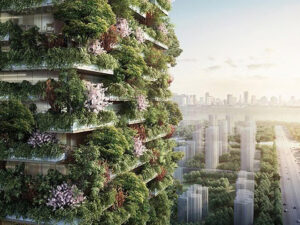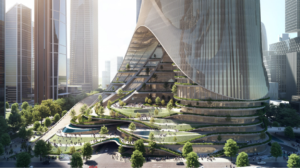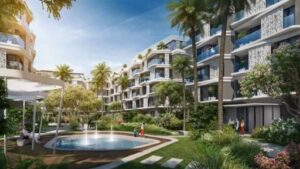A Prosperous Chalice : Modernity’s Adoration for Nature and Architecture
Written By: Morouje Sherif
Edited By: Morouje Sherif
Design By: Morouje Sherif & Samantha Porte
Published By: Samantha Porte
INTRO
Millennia’s obsession—the vibrant, treacherous pinpricks of adoration: succulent, fiddle-leaf fig, and elusive varicolored monstera. Yes, it is our generation’s weakness to mixed green leaves. But aside from this shared bond, one has never been asked: what are the origins of these soft spots? Most importantly: how has society capitalized on yet another trend? The time has come for humanity to learn these valuable introspections—to fulfill a chalice of great inspiration and once-lived scarce motivation.
It’s innocent loving.
When we seem never to be valued, we seek reconciliation to prove our worth. And flowers—which retain their assorted docility and optimism of growth—forage an unforeseen kindness to nourish humanity in our most burdensome moments. Who else may delight with their effortless shapes, liberating patterns and striking colourings?
In an era where we place extensive restrictions on security and perfection, nature becomes the best friends we would have never thought were ethically attainable. It’s the psychological retreat we cling to anywhere, unfailingly desired.
People are designed for connection and nurturing. It’s the lineage of our past and how our generation continuously evolved. Yet, with more Millennials waiting until later in life to continue their offspring, more young adults are turning to pure nature to fulfill their nurturing.
Plants—more or less—are the introverted superiors of their existence. Contrary to giddy pets and, of course—apathetic fish and the occasional pet rock, a beloved succulent will never add more fuel to the fire: covering the walls in markers or sampling the furniture. Yet, ultimately, they still achieve humanity’s desire to birth fulfillment. Envision how awe-inspiring their growth becomes: beginning with one or two leaves and a short height—and by placing it next to the window so it gets a bit of light and a generous sprinkling of water, it evolves into something stunning right in our eyes.
Further, like humans, plants also have their own creative identity, making their mark in the most common places we visit—becoming a crucial part of remembering such locations. It’s like going to an area with someone you cherish. The site inevitably becomes linked to that person—and you remember them each time you visit.
The ecological adoration also has to do with the exponential blossoming of Millennia’s desire for self-care and wellness trends—from fitness classes, food, local produce, gardening, and even athleisure fashion being a staple in our concurrent values of comfort and chic fashion.
At the end of the day, our productive generation wants to come home to a calming and freeing space that no other species but plants can fulfill. If you’re a social butterfly? You are in luck: because nature inversely caters to unparalleled vibrancy with its spotlighted colours and patterns. So now we ask: how has modernity’s leafy obsession transcended?
Simplicity, remodelled.
Plants in urban areas are a tenet to innovate modern-day architecture, ecosystem services, and mitigating the overall impacts on human presence. As we have slowly become more aware of the detriment we have caused to our ecosystem, we have consistently pondered the floating questions of how to live more sustainably and create consistent progress.
Owing to the uncontrollable growth of cities, the need for sustainable development has grown. Continuously modelled in our school curricula, sustainable development’s rigorous definition is known as the development that meets the needs of the present without compromising the ability of future generations to meet their own. Though, we must admit one commonality: it is that society is absolutely lazy. The complex thought of “living sustainably” is always in the back of our minds and yet never executed. Humanity has grown more accepting of the sensory key signals of visual cues—if you see a pen, you will remember to do your English homework. Bought a t-shirt with an eco-friendly logo? You believe your money is suddenly more worthwhile. If you see plants and a residence, you automatically think you are living sustainably.
What does this mean for society? It’s that nature, for both its aesthetic pleasure and endless resourcefulness, has shaped the development of residences to address a new perception of architectural space. Not only that, but space itself is meaningless without human intervention or nature—which arises the discovery that humanity alike and architects must consider these “cities for people” more seriously. The metropolis suddenly becomes more friendly, livable, and attractive with a sustainable implementation, as humanity-cherished nature instigates in the daybreak.
 Striving to make buildings more sustainable while saving construction costs and occupation is not only an ethical matter but the basis of any architecture. This methodology of architecture, vegetation, and sustainable development is what we understand as green buildings. (Figure 2.1)
Striving to make buildings more sustainable while saving construction costs and occupation is not only an ethical matter but the basis of any architecture. This methodology of architecture, vegetation, and sustainable development is what we understand as green buildings. (Figure 2.1)
While it looks seemingly messy, green buildings don’t simply scope such tall, treacherous monstrosities. They also branch out to modernity, abstraction, simplicity and beauty. Take a look at Figure 2.2, which shows the Tower C skyscraper in Shenzhen, China, made by the acclaimed architect Zaha Hadid. Featuring deltas of greenery, this sleek and marbled vision also implements the principles of green architecture: inspired by the Russian Avant-garde artistic movements and art movements like Futurism, Constructivism and Suprematism.
In school, we are told to live sustainably but never follow through. Yet—it’s time to realize that sustainability exists in everything, even in the upbringing of artistic compositions and places we visit regularly. Sustainability is an ethic that stands to support our livelihoods more than an ethic that promotes our societal structure—because who really ever listens in class? 
In Egypt, the supermodern development of the rich Badya Palm Hills villas is an architectural pullout—and a cultural hub that initiates a platform to prosper and engage through the creation of residencies, parks, and even academic institutions and universities, thriving an opulent community in the country. Figures 2.3 and 2.4 illustrate the architectural design of the compounds, and what is not to love about them? (Figure 2.2)
After taking a vacation to the country, I was able to visit the crystalline compounds and the virtuous passion for using technology and architecture to enhance the livelihoods of both the status quo and humanity alike, both in Egypt and worldwide. As Egypt has close ties with Europe, plenty of funding and design of the compounds exchange cross-culturally. Not only does this dictate a long-lasting effort for sustainability and its development, but also an initiative that crosses borders in North America. It emphasizes how we are all striving for the same goal—let it be a grandeur initiative like architecture, or simply planting a flower garden.


(Figure 2.3) (Figure 2.4)
A beautiful example of other green spaces includes the Earthitects workspace, illustrated in Figure 2.5. This Indian architectural practice transforms its head office into an eco-friendly workspace, which assists in thriving employee morale in an informal space. Combined with various elements and designs of hazelly wood, this workspace transforms labour into sturdy tables, workstations and lighting. The design revolves around nature with its liberating, organic sensation. Earthitects contrives wondrous residents and resorts that blend the untainted beauty of nature into furnishings of clay, wood and stone. Additionally, they use the land to birth agriculture for life, as exemplified through their core purpose by existing to facilitate life in its abundance by enabling complete enjoyment of creative inspiration. (Figure 2.4)
Your imminent calling.
So, why do these architectural analyses matter? As we venture into adulthood, it is a certainty that we will eventually have to make decisions that concern environmentalism daily. And due to the increased trend in environmentalism, that will become an inherent policy that we might invest in or not. We constantly see attractive specialties on the market that enhance our livelihoods, and we must ask ourselves if it works to our benefit in the present and the future.
Although we cannot legally purchase a house or be the personified definition of an environmentalist, anything can be environmentalism—and that all stems back to our generation’s craze with plants, nourishment and cherished adoration for nurturing growth. Unfortunately, when we think of enhancing our lives or blossoming motivation, we rarely become inclined to do so—as inefficient yet homogenous as our generation stands.
Why not infuse a psychological enhancement in our lives? For example, buying a succulent to heart right at your desk that prospers inspiration to get your homework done—or planting flowers right beneath your window to wake up to vibrancy and rosiness. Further, it provides decoration in a dull space—a transient spontaneity of perfection.
CONCLUSION
Thinking to start and never starting is humanity’s worst mistake of unproductivity. It’s how we lose the branches to bear creativity and why we consistently seek others for our backbone of inspiration. So the next time you see any form of inspiration, whether it be a minimal decoration, a succulent to forage an identity of environmental action, or even a compelling volunteering opportunity to build your character—sustainability doesn’t mean only living a single-named lifestyle. Instead, like many of our other perceptions, it blossoms a new existence: of artistry, beauty, and comfort, flavouring a fruitful chalice of wonder.
BIBLIOGRAPHY
Fineschi, S., & Loreto, F. (2020). A survey of multiple interactions between plants and the urban environment. Frontiers. Retrieved May 26, 2022, from https://www.frontiersin.org/articles/10.3389/ffgc.2020.00030/full
Haupt, P. (n.d.). Architecture vs. nature: A reinvented relationship. Retrieved May 26, 2022, from https://www.witpress.com/Secure/elibrary/papers/ARC14/ARC14004FU1.pdf
Private residences: Architecture. Earthitects. (n.d.). Retrieved May 28, 2022, from https://www.earthitects.com/
Stathaki, E. (2022, May 17). Sustainable architecture: Innovative and inspiring building design. Retrieved May 28, 2022, from https://www.wallpaper.com/architecture/sustainable-architecture-innovation
Figure 2.1 [Photograph of Green Towers in Nanjing, China]. (n.d.). Retrieved May 27, 2022, from https://www.volvoce.com/global/en/news-and-events/news-and-stories/2019/five-of-the-worlds-most-inspiring-green-buildings/
Figure 2.2 [Photograph of Zaha Hadid Architects Tower C Shenzhen Bay Super Headquarters Base]. (n.d.). Retrieved May 27, 2022, from https://www.designboom.com/architecture/zaha-hadid-tower-c-shenzhen-bay-super-headquarters-base-01-11-2021/
Figure 2.3 [Photograph of Egypt Badya 6th of October Palm Springs Compound]. (n.d.). Retrieved May 27, 2022, from https://realestate.eg/en/blog/6th-of-october-compounds/location-of-badya-palm-hills-compound
Figure 2.4 [Photograph of Egypt Badya Palm Springs Penthouse]. (n.d.). Retrieved May 28, 2022, from https://estaties.com/properties/badya-palm-hills/
Figure 2.5 [Photograph of Earthitects head workspace in Bengaluru, India]. (n.d.). Retrieved May 27, 2022, from https://www.wallpaper.com/architecture/sustainable-architecture-innovation

